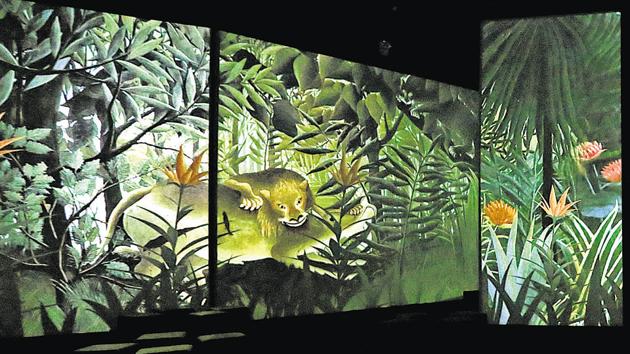‘Inside’ a work of art: A review of the exhibition The Drifting Canvas
An ongoing exhibition of art by European masters is a bewitching 3D audio-visual immersive experience that breathes life into the paintings. There’s also a section of works by Indian artists
Russian artist Wassily Kandinsky lived a life that was nothing short of epic in itself. Born in Russia, Kandinsky ended up teaching in Germany during the rise of the Nazis and eventually settled in France as a citizen. As a pioneer of abstraction, Kandinsky has grown in reputation since his death. In keeping with his travels and his journey, his work would be littered across Europe; but it’s a trip not many, regardless of their interest in his art, can undertake. The Drifting Canvas, a multimedia exposition that brings together around 2,000 works of 11 European artists, seeks to address this very problem.

Spanning more than 800 sq metres of carpet space in the Pavilion of Select Citywalk, with more than 20 giant high definition screens, The Drifting Canvas is an immersive audio visual treat, that takes you quite literally ‘into’ the works of Europe’s most famous artists. How is it any different from viewing these paintings on, maybe, your laptop? “This is a multimedia exhibition. It isn’t just putting the canvas on a TV screen. Unlike a stream of pictures, each of these paintings has been storyboarded. There are eight-nine storyboards behind each work, which decide the movement of its elements and the effects. It is quite technical,” Yasha Yavorskaya, curator of the exhibition says.
The exposition’s first leg, called the Anteroom, is a text-and-image tutorial, guiding the viewer through the various movements in art around the turn of the 19th century, invoking each of the artists featured in the exposition.

A portrait of actor Waheeda Rehman, drawn by local artist Kanchan Chander. The last leg of the exhibition showcases work by artists closer to home.
From impressionism, through post-impressionism to Russian Suprematism, almost all significant turns in the narrative of artistic technique and thought are represented. But curiously, Cubism is missing. And it has to do with its most popular proponent that many in India also emulated – Pablo Picasso. “Not only are his works difficult to represent, his estate isn’t particularly comfortable with what we do with the works of other painters. They are not easy to deal with,” Yasha says.
As you move from the Anteroom, television screens in a corridor help you view animated abstracts of Kandinsky through 3D glasses. It is a surreal experience.
The 11 European Greats You Can See Here
Claude Monet - One of the founding fathers of French impressionism
Edgar Degas - French impressionist who predominantly drew around dance
Paul Gauguin – First of French painters to embrace post-impressionism
Vincent Van Gogh - Perhaps the most famous post-impressionist. A man who suffered from psychotic delusions and famously chopped off his own ear
Paul Signac – French painter who helped develop pointillism, the idea that brush strokes should not merge within the canvas but in the viewer’s eye
Henri Rousseau – A self-taught painter, and a toll collector for most of his life, Rousseau went back to prehistoric times
Henri de Toulouse-Lautrec - Painter of the Moulin Rouge posters, Lautrec’s knowledge and experience of theatre in Paris shaped his art
Amedeo Modigliani – Italian painter most famous for his portraits without eyes
Gustav Klimt -
Austrian symbolist, one of the greatest decorative painters of his era, influenced by
Japanese artists
Wassily Kandinsky – Russian avant garde painter, one of the first practitioners of abstract art
Kazimir Malevich – Considered one of Russia’s most important artists, Malevich brought geometry and shapes into the aesthetic realm
The second leg of the exposition, however, is the chief attraction. A humbling, bewitching audio-visual spectacle that at times feels like sorcery. On giant screens, the works appear, are often drawn or put together in phases, or their elements animated, as if alive, all to the tune of hypnotic modern western classical music. The moon in Van Gogh’s Starry Night slowly revolves, the sea ripples, birds fly in Rousseau’s view of the wild, and Paul Signac’s pointed sores appear and disappear.
Technology, through its modulation of light, colour, sound and in this case even movement has infused these works with a curious energy and life. But how is each element within a canvas pulled and its movement arrived at? “It has taken us a couple of years obviously. We can’t drift away from what these great artists intended in the first place,” Yasha says.

A ballerina from one of Edgar Degas’ works that revolve largely around the life of dancers and tried to capture their movement.
Infusing life into works that are supposed to be experienced in the original may come as an insult to traditionalists who would be against the multimedia appropriation of works that they would say are relics and should remain so. Yasha believes that there is no argument against it, that viewing the actual work is any day the ideal way to experience the works.
“What we are trying to do is basically bring these scattered works together, put life in them so even those who feel uninterested in art, can engage with it, maybe even want to go and view the original,” she says.
What: The Drifting Canvas
When: 10 am to 9pm, till June 15
Where: Pavilion at Select City Walk, Saket. Nearest Metro station: Malviya Nagar
Entry: Tickets priced from ₹100 to ₹850





